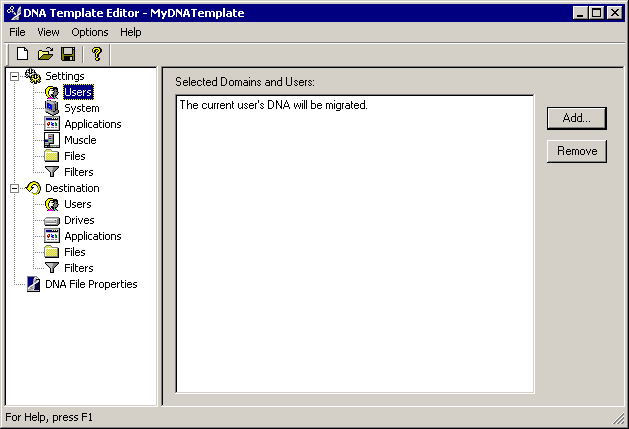Using the DNA Template Editor to Create the Template
Each customer can have specific requirements for his or her personality migration. It is outside the scope of this guide to define the various implications and parameters for each migration.
The main factors that will drive the complexity and, ultimately, the size and scope of the personality migration, are whether the legacy environment is well managed, whether the customer has an existing Standard Operating Environment (SOE), how many laptops and remote users are part of the migration project, and how much data is stored locally on workstations as opposed to network storage.
Desktop DNA templates can be thought of as policies defining the collection of settings and data from the legacy workstation.
To create the Desktop DNA template in the Template Editor:
-
Click Start > Programs > Novell ZENworks Personality Migration > Migration Management Toolkit > DNA Template Editor.

-
Select your template settings.
For detailed information about the Template Editor, see the online Help in the DNA Template Editor. The Help topics contain detailed information about the following settings:
Users: Lets you add or remove user profiles from your template. Unless you are a system administrator and logged into a system supporting multiple profiles, only the current user's settings are migrated. Current User is designated as the user who is logged into the computer at the time of the migration.
If the user is not an administrator who is logged in during the migration, then you should not add any users to the template. You should simply use the default, which is the current user logged into the system at the time of the migration. If you are only going to migrate the Current User, do not add any users to the template.
To add a user, click Users in the left pane of the Template Editor window, then click the Add button on the right side. You can use the Domains, Local, Special, and Unlisted tabs in the Add Users dialog box to select the user that you want to add.
System: Lets you edit all the system settings listed in the right pane of the Template Editor window.
To select System settings, click System in the left pane of the Template Editor window, click the Add button on the right side, then select the desired settings.
You can expand the folders by clicking the plus sign (+) next to each item.
Applications: Lets you edit application selections, such as applications, their settings, and their associated documents.
To select Application settings, click Applications in the left pane of the Template Editor window, click the Add button on the right side, then select the desired settings.
You can expand the folders by clicking the plus sign (+) next to each item.
Muscle: Lets you migrate applications for which there are no scripts available. These are called Muscle Migrations.
To select Muscle settings, click Muscle in the left pane of the Template Editor window, then click the Add button on the right side. Enter the filename for the application's executable. If you browse to locate the application's executable, remove the path information so that you can migrate this executable wherever it is located on the computers being migrated. Select the check boxes to specify that you want to migrate the application, its settings, and its associated documents on local drives, then click Add.
Files: Lets you edit file and folder migration selections.
To select Files settings, click Files in the left pane of the Template Editor window, click the Add button on the right side, then select the desired settings.
You can expand the folders by clicking the plus sign (+) next to each item.
Filters: Lets you edit the filters you created to implement a search for files, folders, or drives.
To select Filters settings, click Filters in the left pane of the Template Editor window, click the Add button on the right side, then select the desired settings.
-
To create the Desktop DNA template, click File > Save.
-
Use the default template name, mydnatemplate.dtf, or give the template a descriptive name and save the file on the server in the \ddna\templates directory that you created in Creating the Desktop DNA Template Store.
-
Click Save.
For the purposes of this guide, after you save the template, you are ready to create the Desktop Management Application objects to collect and apply the personality information. See Creating the Application Object to Collect the Personality and Creating the Application Object to Apply the Personality for more information.
-
Click File > Exit.